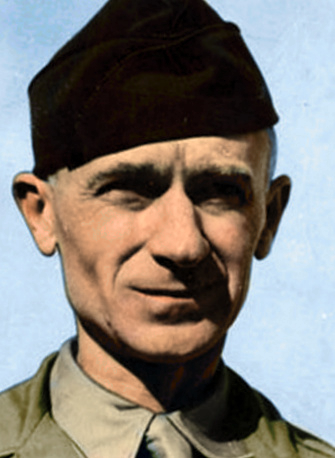The Pittsburgh Press (August 21, 1944)

Roving Reporter
By Ernie Pyle
On the Western Front, France – (by wireless)
We ran to the wrecked British plane, lying there upside down, and dropped on our hands and knees and peeked through a tiny hole in the side.
A man lay on his back in the small space of the upside cockpit. His feet disappeared somewhere in the jumble of dial and rubber pedals above him. His shirt was open and his chest was bare to the waist. He was smoking a cigarette.
He turned his eyes toward me when I peeked in, and he said in a typical British manner of offhand friendliness, “Oh, hello.”
“Are you alright?” I asked stupidly.
He answered, “Yes, quite. Now that you chaps are here.”
I asked him how long he had been trapped in the wrecked plane. He said he didn’t know for sure as he had got mixed up about the passage of time. But he did know the date of the month he was shot down. He told me the date. And I said, out loud, “Good God!”
For wounded and trapped, he had been lying there for eight days.
His left leg was broken and punctured by an ack-ack burst. His back was terribly burned by raw gasoline that had spilled. The fool of his injured leg was pinned rigidly under the rudder bar.
His space was so small he couldn’t squirm around to relieve his own weight from his paining back. He couldn’t straighten out his legs, which were bent above him. He couldn’t see out of his little prison. He had not had a bite to eat or a drop of water. All this for eight days and nights.
Yet when we found him, his physical condition was strong, and his mind was as calm and rational as though he were sitting in a London club. He was in agony, yet in his correct Oxford accent he even apologized for taking up our time to get him out.
The American soldiers of our rescue party cussed as they worked, cussed with open admiration for this British flier’s greatness of heart which had kept him alive and sane through his lonely and gradually hope-dimming ordeal.
One of them said, “God, but these limeys have got guts!”
It took us almost an hour to get him out. We don’t know whether he will live or not, but he has a chance. During the hour we were ripping the plane open to make a hole, he talked to us. And here, in the best nutshell I can devise from the conversation of a brave man whom you didn’t want to badger with trivial questions, is what happened…
He was an RAF flight lieutenant, piloting a night fighter. Over a certain area the Germans began letting him have it from the ground with machine-gun fire.
The first hit knocked out his motor. He was too low to jump, so – foolishly, he said – he turned on his lights to try a crash landing. Then they really poured it on him. The second hit got him in the leg. And a third bullet cut right across the balls of his right-hand forefingers, clipping every one of them to the bone.
He left his heels up, and the plane’s belly hit the ground going uphill on a slight slope. We could see the groove it had dug for about 50 yards. Then it flopped, tail over nose, onto its back. The pilot was absolutely sealed into the upside-down cockpit.
“That’s all I remember for a while,” he told us. “When I came to, they were shelling all around me.”
Thus began the eight days. He had crashed right between the Germans and Americans in a sort of pastoral no-man’s-land.
For days afterwards the field in which he lay surged back and forth between German hands and ours.
His pasture was pocked with hundreds of shell craters. Many of them were only yards away. One was right at the end of his wing. The metal sides of the plane were speckled with hundreds of shrapnel holes.
He lay there, trapped in the midst of this inferno of explosions. The fields around him gradually became littered with dead. At last American strength pushed the Germans back, and silence came. But no help. Because, you see, it was in that vacuum behind the battle, and only a few people were left.
The days passed. He thirsted terribly. He slept some; part of the time he was unconscious; part of the time he undoubtedly was delirious. But he never gave up hope.
After we had finally got him out, he said as he lay on the stretcher under a wing, “Is it possible that I’ve been out of this plane since I crashed?”
Everybody chuckled. The doctor who had arrived said:
Not the remotest possibility. You were sealed in there and it took men with tools half an hour to make an opening. And your leg was broken and your foot was pinned there. No, you haven’t been out.
“I didn’t think it was possible,” the pilot said, “and yet it seems in my mind that I was out once and back in again.”
That little memory of delirium was the only word said by that remarkable man in the whole hour of his rescue that wasn’t as dispassionate and matter-of-fact as though he had been sitting comfortably at the end of the day in front of his own fireplace.